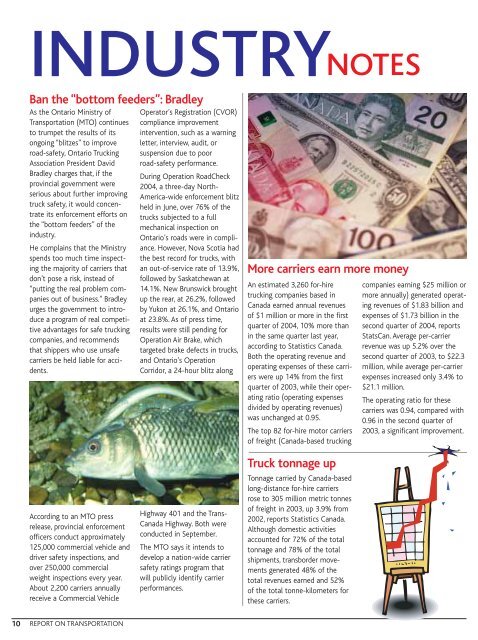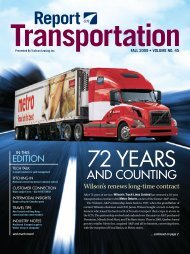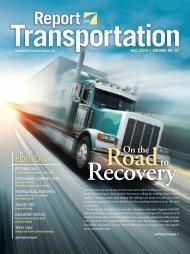Fall 2004 - Trailcon
Fall 2004 - Trailcon
Fall 2004 - Trailcon
Create successful ePaper yourself
Turn your PDF publications into a flip-book with our unique Google optimized e-Paper software.
INDUSTRYNOTESBan the “bottom feeders”: BradleyAs the Ontario Ministry ofTransportation (MTO) continuesto trumpet the results of itsongoing “blitzes” to improveroad-safety, Ontario TruckingAssociation President DavidBradley charges that, if theprovincial government wereserious about further improvingtruck safety, it would concentrateits enforcement efforts onthe “bottom feeders” of theindustry.He complains that the Ministryspends too much time inspectingthe majority of carriers thatdon’t pose a risk, instead of“putting the real problem companiesout of business.” Bradleyurges the government to introducea program of real competitiveadvantages for safe truckingcompanies, and recommendsthat shippers who use unsafecarriers be held liable for accidents.Operator’s Registration (CVOR)compliance improvementintervention, such as a warningletter, interview, audit, orsuspension due to poorroad-safety performance.During Operation RoadCheck<strong>2004</strong>, a three-day North-America-wide enforcement blitzheld in June, over 76% of thetrucks subjected to a fullmechanical inspection onOntario’s roads were in compliance.However, Nova Scotia hadthe best record for trucks, withan out-of-service rate of 13.9%,followed by Saskatchewan at14.1%. New Brunswick broughtup the rear, at 26.2%, followedby Yukon at 26.1%, and Ontarioat 23.8%. As of press time,results were still pending forOperation Air Brake, whichtargeted brake defects in trucks,and Ontario’s OperationCorridor, a 24-hour blitz alongMore carriers earn more moneyAn estimated 3,260 for-hiretrucking companies based inCanada earned annual revenuesof $1 million or more in the firstquarter of <strong>2004</strong>, 10% more thanin the same quarter last year,according to Statistics Canada.Both the operating revenue andoperating expenses of these carrierswere up 14% from the firstquarter of 2003, while their operatingratio (operating expensesdivided by operating revenues)was unchanged at 0.95.The top 82 for-hire motor carriersof freight (Canada-based truckingcompanies earning $25 million ormore annually) generated operatingrevenues of $1.83 billion andexpenses of $1.73 billion in thesecond quarter of <strong>2004</strong>, reportsStatsCan. Average per-carrierrevenue was up 5.2% over thesecond quarter of 2003, to $22.3million, while average per-carrierexpenses increased only 3.4% to$21.1 million.The operating ratio for thesecarriers was 0.94, compared with0.96 in the second quarter of2003, a significant improvement.According to an MTO pressrelease, provincial enforcementofficers conduct approximately125,000 commercial vehicle anddriver safety inspections, andover 250,000 commercialweight inspections every year.About 2,200 carriers annuallyreceive a Commercial VehicleHighway 401 and the Trans-Canada Highway. Both wereconducted in September.The MTO says it intends todevelop a nation-wide carriersafety ratings program thatwill publicly identify carrierperformances.Truck tonnage upTonnage carried by Canada-basedlong-distance for-hire carriersrose to 305 million metric tonnesof freight in 2003, up 3.9% from2002, reports Statistics Canada.Although domestic activitiesaccounted for 72% of the totaltonnage and 78% of the totalshipments, transborder movementsgenerated 48% of thetotal revenues earned and 52%of the total tonne-kilometers forthese carriers.10REPORT ON TRANSPORTATION






